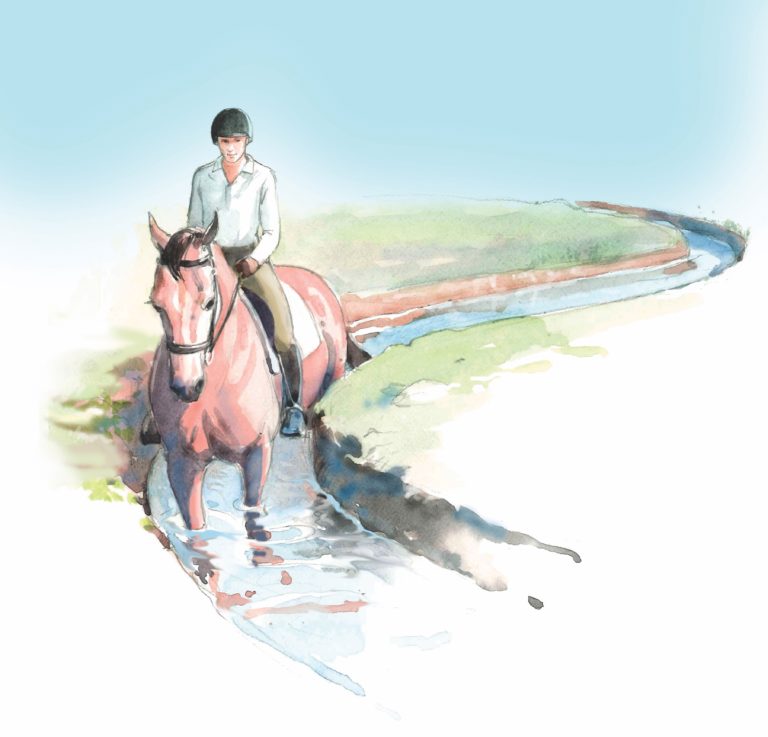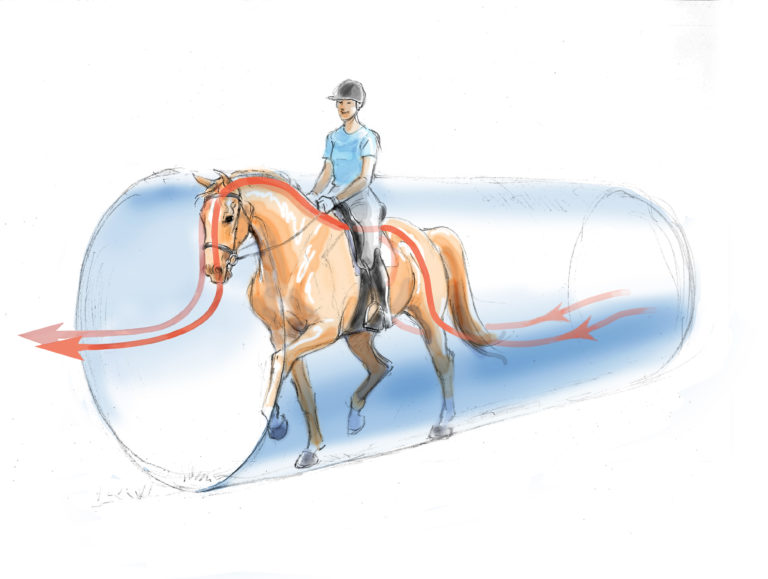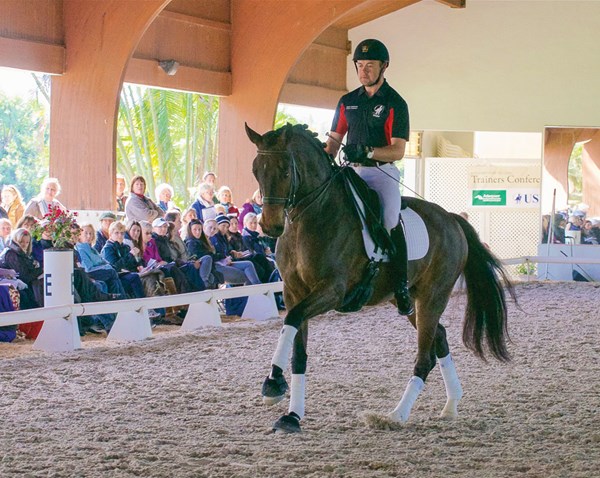
USDF’s East Coast FEI Trainers Conference is hosted annually by Mary Anne McPhail at her High Meadow Farm in Loxahatchee, Florida, and this time Johann Hinnemann of Voerde, Germany, was the educator. Throughout the two-day clinic, held January 18 and 19, Hinnemann’s theme was clear: He first wanted to see horses that were submissive (supple and obedient) and balanced in their warm-ups. Later, riders could ask for more power and expression.
Submission
Mental and physical suppleness, together with obedience, give us a submissive horse—or one that is willingly cooperative. Hinnemann explained that the word “submission,” which has so often been misunderstood, has been removed from the FEI Rule Book and replaced by the term, “willing cooperation,” which more accurately describes the intended meaning of the term “submission.”
“Willingly cooperative horses are obedient and supple both mentally and physically,” he said. “As a result, they can come into balance and then we can we teach them.”
U.S. Olympian Christine Traurig, Hinnemann’s assistant, commented on how beautifully some of the riders demonstrated the relaxation and suppleness that, in German, is called, Losgelassenheit (literal translation: “letting-go-ness” of physical and mental tension). She clarified that it is not making the horse give in. Hinnemann added, “In true submission, the horse lets the aids go through from back to front and also from front to back, left to right and right to left.”
Warm-Up
Each horse spent at least 10 to 15 minutes in walk before starting the rising trot. Several of the horses showed phenomenal movement, but Hinnemann wanted the warm-up to be ridden without too much expression. He wanted relaxation and suppleness first along with the rhythm and swing of the back that come as a natural result. “If the horse goes too much forward,” he said, “you have to hold too much with your hands. Avoid that.”
Hinnemann also warned against the dangers of riding behind the vertical and behind the motion of the horse. “Upper body forward,” he often advised. “When riders lean back, they put more weight on the hind legs, making it more difficult for the horse to lift the hind leg up and under. Then they become slower. Aim to lighten the horse’s back.”
All the horses in the program had many walk breaks that were quiet and relaxing but active. Throughout the warm-up, he focused on transitions and the development of an ideal connection.
The Connection
“Get the noseline out!” was a common phrase. Hinnemann was insistent that each horse reach for the bit with the noseline forward. “From the beginning,” he said, “the rider must have the desire to bring the noseline out, and the horse must reach out from the rider’s driving seat.” Hinnemann told one rider that her horse carried himself too much with the underneck. He wanted her to lengthen the neck and “open the jaw”—a phrase that many people didn’t understand. Traurig explained that he meant to open the throatlatch so the horse reached for the bit without shortening the neck.
On the other hand, one of the riders rode her horse with the nose too much in front of the vertical, which prevented the horse from coming through. Hinnemann described the ideal connection not as between the hand and the mouth, but rather, between the rider’s entire body, including the hand, and the mouth.
Transitions
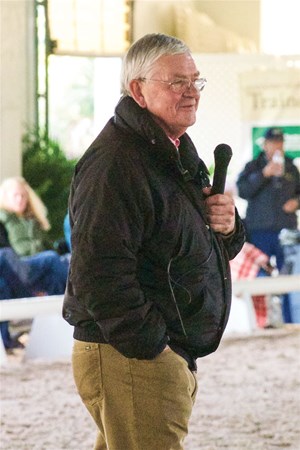
Hinnemann had a consistent training routine of transitions for all the horses in the conference. First, he asked for transitions forward and back in trot on an accurate 20-meter circle. Next, they moved on to trot–canter–trot transitions, which he described as one of the most difficult exercises and the best for developing suppleness. “Think about leg-yield in each transition,” he advised. Before each canter depart, he wanted to see half halts with the visible result of more balance on the hindquarters. In the aid for the canter departure he didn’t want too much outside leg: “Put your inside leg lower, which puts weight on the inside seat bone.”
In the transition from canter to trot, he wanted the riders to be able to push (not pull) into the downward transition to trot. “You must be able to push into all downward transitions,” he said.
They moved on to transitions on the centerline down to halt and up again to trot. Of course, many points are won or lost on the centerline, therefore Hinnemann’s students practice this often. Then they did walk–canter–walk transitions, which Hinnemann described as the most important exercise in dressage training. “The canter departure,” he said, “must be so easy that in the end, when you think about canter pirouette on the centerline, every stride is a canter depart.” He reminded riders that the highest degree of suppleness is necessary for those FEI movements. And every movement begins with a transition that comes from a committed hind leg. The hind legs must be committed to pushing and carrying, and the rider has to have control of the ratio between the two.
Often in the extended paces, a horse’s hind legs are inclined to become wide, at which point engagement (weight-bearing of the hind legs) is lost and the horse goes on the forehand. Hinnemann asked for frequent transitions, which prevented this loss of balance. He reminded riders, “You will know it is correct when you are able to push at the end of the diagonal as well as in the beginning.” Quality transitions prepared the horses’ basic gaits for doing movements.
Shoulder-in, Travers and Half Pass
Hinnemann discussed the purposes of exercises. “The reason we do shoulder-in, for example, is to straighten the horse,” he said. “If you do it without thinking about the purpose, then you lose the effect.” He encouraged riders to control the bend in the corner so the horse could be in front of the leg and balanced before each movement. “If you have control in the corner, you can prepare for the next exercise,” he said.
Then he addressed a common problem in shoulder-in: “Be sure your inside leg is not back,” he said. “Keep your hands down and in the direction of the mouth.” He encouraged riders to find greater cadence so that they could turn a score of 6 into a 7 or a score of 7 into an 8. “To get more expression,” he said, “push so that the horse’s outside front leg swings out. Then, at the same time, the inside hind will be able to come under the center of gravity.”
In travers, or haunches in, he told riders that their horses needed to look straight down the track into the mirror to align the forehand. “Then when you put that line onto the diagonal, you get half pass and the horse must look toward the end of that line. For example, on the line from M to K, the horse has to look at K.” He explained that as the half pass of the horse advances through the levels, the degree of throughness and bend as well as the steepness of the angle increases, so the horse goes from M to V, and then in the Grand Prix, from M to E. He must always look where he’s going and then the horse bends behind you. He explained the preparation: “Come out of the corner absolutely straight and when the horse looks down the line, you then bend the horse behind you.” He said the sign of a good half pass is when you can bring the balance and quality of the collected trot on the short side into the movement. “Start from shoulder-in,” he said, “and then sit to the inside, use both legs and move over.” He asked one rider for more and more bend as she and her horse proceeded down the diagonal line. “This increases the cadence and swing of the trot,” he said, “which, if you have no rhythm mistakes, will make the half pass spectacular. If you lose the cadence in the half pass,” he advised, “go back to shoulder-in to regain the balance and then return to half pass.”
One rider did travers in canter down the long side with the horse’s poll up and noseline out. “This supples the horse behind the saddle and helps him separate his hind legs,” Hinnemann said. “It develops the pirouette canter, which requires bending of all the joints of the hind leg. Likewise, canter–walk–canter transitions in haunches-in on a circle develop the ability to carry weight behind. We get the horse stronger and more flexible bit by bit,” he said. “Do this every day so the horse will carry weight more easily.”
Flying Changes
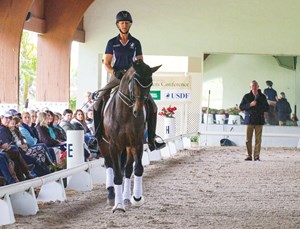
The better the moment of suspension, the easier it is to change the lead, so Hinnemann wanted activity in the canter. He explained that “more jump” means more activity without the horse going more forward. When the transitions to canter were easy, Hinnemann was ready to introduce flying changes.
The riders were first asked to leg yield in canter away from the leading leg and then toward the leading leg. Then they incorporated counter canter, half pass and transitions from canter to a quiet walk, followed by balanced and obedient canter departs. “Never forget shoulder-fore in both directions,” he reminded the riders often. When the balance was ideal, they incorporated flying changes from the leg yields.
Some riders tried to give too much of the aid with the outside leg, which tended to collapse the rider’s hip in the change. “Just bring weight to the new inside seat bone,” Hinnemann said.
The Line of Travel
Hinnemann was persistent that riders guide their horses on very precise figures. On the 20-meter circle, he explained that the corner letters are 6 meters from the corner and the other letters are 12 meters apart, giving 18 meters from each corner to the R–S–V–P letters. “Two meters more give you the 20-meter circle point on the centerline,” he said. “Use your inside leg and ride a precise 20-meter circle with no corners. The horse must be obedient to the inside leg and the rider must be particular about the line of travel and ride correctly bent lines,” he said, “so the horse’s spine is on the line of the circle.” Later, in half pass, Hinnemann was, again, insistent that horses stay on the line of travel. “Point his nose toward the letter where you want to end up,” he said, “and then get the bend behind you.
“Only when you concentrate on the line of travel can your aids and your seat be correct,” he continued. “And the right seat and the right aids give you the right result.”
Meet the Riders
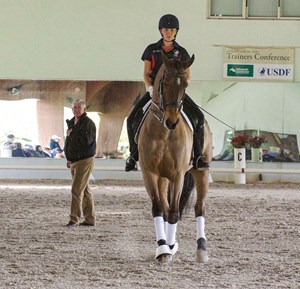
Endel Ots rode the 6-year-old Hanoverian gelding, Lucky Strike, whom he owns with his father Max. In 2015, Ots rode this horse as a 5-year-old in the World Young Horse Championships in Verden, Germany, finishing second in the small final and 11th in the world. Ots also rode Samhitas, a 7-year-old Oldenburg gelding by Sir Donnerhall, owned by Gary and Jaimie Vander Ploeg, Mike Rucchi and Max Ots. Ots is a USDF bronze, silver and gold medalist and he has earned his bronze, silver and gold freestyle bars.
Melissa Jackson rode Domani, a 6-year-old Hanoverian gelding by Dimaggio, owned by Marcie Biondolillo. Jackson is a USDF bronze, silver and gold medalist and a recent graduate of the “L” Education Program.
JJ Tate rode Kynynmont Gunsmoke’s Gideon, a 7-year-old Connemara Pony gelding by Gunsmoke, owned by Pam Liddell. As a Young Rider, Tate competed on three NAJYRC teams, earning a team silver medal. In 2005 she was the reserve rider for the World Cup and long-listed for the World Equestrian Games. She is a USDF bronze, silver and gold medalist. In 2007, she represented the U.S. at the World Young Horse Championships in Verden, Germany, where she was the highest-placed American rider.
Heather Blitz rode Ripline, an 8-year-old Danish Warmblood stallion by Hotline, whom she owns with Oak Hill Ranch. Blitz was a member of the 2011 Pan American Games team, earning team gold and individual silver. She was the reserve rider for 2012 Olympic Games with Paragon. In 2014 she rode Ripline to a Third Level Championship at the U.S. Dressage Finals presented by Adequan and the Markel/USEF Young and Developing Horse National 6-year-old Championships. In 2015, the pair earned reserve champion in the Markel/USEF National Developing Prix St. Georges. Blitz is a USDF bronze, silver and gold medalist.
Ayden Uhlir rode her own Sjapoer, a 17-year-old KWPN gelding by Contango. In 2012, Uhlir was the NAJYRC Junior individual and freestyle gold medalist and was on the bronze-medal team. Later that year, she became the USEF Festival of Champions junior champion. In 2013, she moved up to Young Riders, winning the individual and freestyle gold medals and becoming the first person to win back-to-back double gold medals. In 2015, Uhlir was part of the U.S. Young Rider team that competed in Europe and attended the Future Championships, placing seventh in the freestyle. She is a USDF bronze and silver medalist.
Mica Mabragana rode Tyara, a 15-year-old KWPN mare owned by Cesar Lopardo-Grana, who rode the mare on the Argentinian team at the 2015 Pan American Games. Mabragana, also a member of the 2015 Argentinian Pan Am team, is a USDF bronze, silver and gold medalist and a USDF certified instructor through Fourth Level. She qualified for the 2014 World Equestrian Games held in France.
Auditors Q&As
Q: You’ve asked a lot of the riders to ride with the poll up. What exactly are the aids for making the poll the highest point?
A: The more you get the hind legs active, the more self-carriage you will get. You keep the poll up by making sure the hind legs stay engaged and active. Traurig added that developing the strength for self-carriage is a process.
Q: When you ask a rider to use the whip on the shoulder, what is the effect you’re looking for?
A: I’m looking for forward desire without loss of rhythm. Often when you use the whip behind the saddle, you get a result from one hind leg, which causes a rhythm mistake.
Q: How do you deal with horses who tilt?
A: The only way is to make the horse move straight so that he goes into both hands with the same weight and connection. Then sit correctly and rebalance. When you go into shoulder-in, for example, start with no flexion so you have an even connection with both hands. You’ll know the connection is correct when you can return to the bend and your horse doesn’t tilt.
Q: Many of the horses in this symposium are very talented. Do you work any differently with normal horses?
A: No. It all works the same.
Q: Can you speak about the transition from Young Riders to the Under-25 Grand Prix?
A: Teaching riders this step is difficult. Juniors and Young Riders need a quiet horse that is rhythmical and cooperative. Then the step to the next level, from Prix St. Georges to Grand Prix, requires a totally different kind of horse—one with quickness and a lot of activity without the need for a whip.
Q: Could you explain how the position of the neck relates to the back— especially in relation to conformation issues?
A: When we consider the quality of the neck, we look at the part in front of the withers. The horse with a low-set neck is inclined to carry the withers down. The exercise of stretching pulls on the muscle that brings the back up. It pulls from both sides—from the hindquarters and from the neck. When the back is up, the withers come up. Then we have more freedom of the shoulder and it is easy to sit.
Johann Hinnemann is recognized worldwide as a trainer and coach and has served as Canada’s team trainer and German national coach alongside Klaus Balkenhol. His student roster reads like a “Who’s Who” of Olympic medalists and various national champions, including Steffen Peters, Coby van Baalen, Marlies van Baalen, Ulla Salzgeber, Heiki Kemmer and Alexandra Simmons de Ridder.



